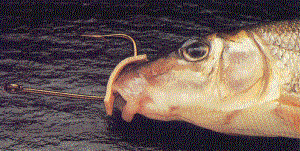 When
I first began sucker fishing back in 1976, I used the recommended method of
the time… that of using single hook rigs. Quick set rigs were seldom used at
that time. Having two record class muskies on during the late ’70’s on
single hook rigs and becoming very proficient at catching muskies by using
this means, only further affirmed my faith in the method. Thoughts about
single hook rigs killing muskies which I chose to release never really entered
my mind at first.
When
I first began sucker fishing back in 1976, I used the recommended method of
the time… that of using single hook rigs. Quick set rigs were seldom used at
that time. Having two record class muskies on during the late ’70’s on
single hook rigs and becoming very proficient at catching muskies by using
this means, only further affirmed my faith in the method. Thoughts about
single hook rigs killing muskies which I chose to release never really entered
my mind at first.
A fellow flowage guide I knew (Wayne Gutsch) did begin expressing concerns during the early ‘80’s that it was likely that many of these fish could be dying and that he viewed single hook rigs as…. kill rigs. Being a single hook fishermen, I naturally didn’t want to believe this. After all, the fish swam away fine after being released and I figured the hooks would just dissolve. In hindsight…. It turned out that Wayne was right about that. But it wouldn’t be until only recently that Wayne’s concerns could be proven with hard facts. In the meantime, I couldn’t help but think about his comments and I certainly began to wonder. And sometime after Wayne started his monel tagging program on the Chippewa Flowage (which began during the late ‘70’s), I saw this as a good opportunity to tag some of my gut hooked muskies – to see if they indeed were surviving. Some of my muskies were recaptured it turned out, but only the ones which were only lip hooked.
By the early ‘90’s, I wondered about this issue even more but – because my children were born at that time – I ended up quitting most of my sucker fishing because of personal constraints on my time. I did experiment with quick sets when I did manage to make it out, but always seemed to gravitate back to my single hooks. But when the CFMS-Y1 study began in 1998, I saw this a great chance to finally get a definitive answer to the single hook mortality question. During the course of this study, 47 muskies were caught, tagged with external radio transmitters, and then were released and followed for the remainder of the season. Being a multi-purpose study, only 9 muskies caught on single hook rigs were able to be "transmittered". Although the batteries on the transmitters ran out by spring and the degree of delayed mortality on these 9 fish couldn’t be fully explored, we were able to confirm that at least half of these fish had died.
 After
this year one study ended, the urgency to more deeply explore this avenue of
the study was realized and we were able to secure the funding from Muskies,
Inc (the Hayward Lakes and South of the Border Chapters) to do a gut hooked
muskie study, solely to find out what percentage of fish were dying from
single hook rigs. Personally thinking that maybe 25% to 50% of the muskies
could be dying, I was shocked to learn the grim facts about single hook sucker
fishing…. that 100% of our study
muskies ended up dying as a result of being gut hooked.
After
this year one study ended, the urgency to more deeply explore this avenue of
the study was realized and we were able to secure the funding from Muskies,
Inc (the Hayward Lakes and South of the Border Chapters) to do a gut hooked
muskie study, solely to find out what percentage of fish were dying from
single hook rigs. Personally thinking that maybe 25% to 50% of the muskies
could be dying, I was shocked to learn the grim facts about single hook sucker
fishing…. that 100% of our study
muskies ended up dying as a result of being gut hooked.
Between October 20th and November 21st of 1999, 14 muskies ranging from 33" to 47 ½" in length were caught on single hook sucker rigs, tagged with an externally mounted radio transmitter at the base of their dorsal fins, and were released to be tracked the following spring once ice out came. All fish had been "gut hooked". Shockingly, we didn’t have to wait until spring to begin seeing the death toll mount. Two muskies died of hook injury to the throat during the process of being tagged and released and two others were discovered dead later…. washed up on shore.
Once tracking began in the spring of 2000, it wasn’t long before all the remaining muskies were located with the radio receiver and their exact locations documented. In testing the accuracy of the equipment and having a transmitter in an unknown location in the lake to the tracker, we were able to get within 30 feet of the transmitter using our receiver. So, once we had each muskie’s loaction pin pointed, then it was simply a matter of repeatedly going back to each fish to see if they had either swum off to a different spot…. Or were dead on the lake bottom.
We soon discovered that most of the muskies by then were resting in their own watery graves – a point which was dramatically illustrated by the fact that the carcasses of two of these dead muskies actually were viewed using an underwater video "fishfinder".
There were two fish of the study group which were actively swimming around through July though. We wondered how these two fish were doing, knowing that most of the others had died. How great it would be to see these fish – just to be able to examine them. Amazingly, both of these fish were caught on hook and line, photographed, and then carefully released by anglers. In talking with them and studying the photos of the fish, it was clear that these muskies were alive…. but were not healthy. They were very thin and it was likely these fish were dying a slow death. Sure enough, by mid July, both of these fish had died too…. Bringing the total death count to 100% of the 14 study muskies which had been gut hooked the previous fall.
Few people probably realized this delayed mortality factor when it comes to sucker fishing and that’s probably why many anglers underestimated how many fish were dying as a result of being gut hooked. A musky caught during the late fall – even if it’s mortally hooked – often can get survive the winter because their metabolism is so slowed . Many of these fish won’t die until spring signals them to again begin feeding in earnest…. Only to have the musky’s internal injuries often condemn the fish to a slow death anyway.
Knowing all this – even though I’ve had great success using the single hook sucker method in the past - in clear conscience I can not continue using this method any longer and I urge all my fellow single hook musky fishermen to do the same on your favorite waters as well. Let’s make sure that the muskies which we choose to release….Really DO SURVIVE. Remember, if the fishing seems to drop off in your pet lake…. perhaps you need only to look into the mirror to discover the reason why.
Now that the facts are in, many other devoted single hook sucker fishermen have since pledged to discontinue using this method and I must also commend all the following local bait shops who have been realized the importance of this issue and have pledged to cease selling all single hook sucker rigs in their shops. Jenk’s Bait Shop, D & B Bait, Dow’s Corner Bait Shop, Happy Hooker, Pastika’s, Hayward Bait and Tackle, and Hayward Super Sports have all promised to remove single hook sucker rigs from their shelves. I applaud them for their conservation minded efforts and hope they will serve as an example to follow to other shops (and anglers as well)….. through out musky country.
The single hook sucker rig study results are in the current issue of Musky Hunter Magazine.